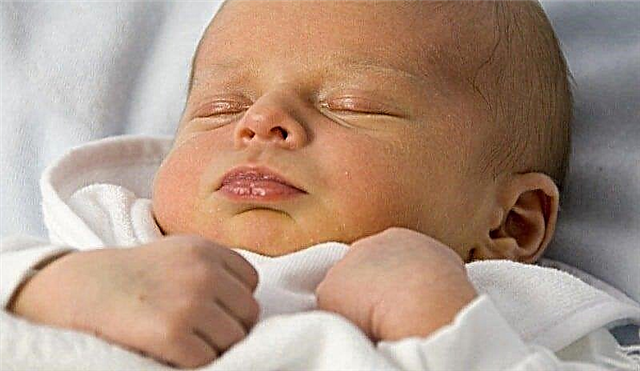The baby was recently born. He looks so small and defenseless. There are special formations on the head of the crumbs - fontanelles. New parents are often afraid to even touch the head, not to mention combing and washing their hair. In addition, there are rumors that it is possible to injure the brain of a crumbs when inaccurately pressing on the fontanel in newborns. There is a lot of talk and prejudice around this area on the head of the child. But is the fontanelle so easily injured in newborns? Is it true that its size and closure time play a huge role in the diagnosis of serious diseases in a child?
What is a fontanelle?
 The skull of a newborn is made up of bones that are joined together by sutures. The bone tissue on the baby's head is thin, pliable, and rich in blood vessels. Some areas on the head do not ossify, they are membranous tissue. They are located at the junction of several bones and are called fontanelles.
The skull of a newborn is made up of bones that are joined together by sutures. The bone tissue on the baby's head is thin, pliable, and rich in blood vessels. Some areas on the head do not ossify, they are membranous tissue. They are located at the junction of several bones and are called fontanelles.
How many fontanelles does a newborn have? Many will be surprised to learn that a child is born with six fontanels.
Where are the fontanelles of a newborn?
The neonate's large fontanelle is the most prominent fontanelle, located at the crown between the frontal and parietal bones. It didn't get its name in vain. Its size is quite large and averages 3 cm. The shape of the large fontanelle is diamond-shaped, and upon closer examination, you can see the pulsation.
Why is the fontanel pulsating? The thin connective tissue that forms the fontanel allows you to see the pulsation of the cerebral vessels and fluctuations in the cerebrospinal fluid. This is an absolutely normal physiological process; you should not worry about the pulsation of the fontanelle.
 The small fontanelle in the newborn is located posterior to the large one at the junction of the parietal and occipital bones. This fontanelle looks like a triangle about 5 mm in size. Often, children are born with an already closed small fontanelle, in the rest it closes within one to two months.
The small fontanelle in the newborn is located posterior to the large one at the junction of the parietal and occipital bones. This fontanelle looks like a triangle about 5 mm in size. Often, children are born with an already closed small fontanelle, in the rest it closes within one to two months.
Two paired fontanelles can be found in the temporal regions. These are wedge-shaped fontanelles. Another pair of fontanelles, mastoid, is found behind the ear. All of them close shortly after the birth of the child and have no diagnostic value.
Why is a child born with fontanelles?
Everything in the human body is no accident, and the child is no exception. The baby's body is a complex system, each organ has its own unique function.
What is the function of the fontanelle in newborns?
- The fontanelle plays an important role during childbirth. Thanks to this formation, the baby's head shrinks and passes through the birth canal more easily. The shape of the head of a baby born naturally is elongated, dolichocephalic. Over time, the head configuration changes, becomes normal, round.
- The child is growing rapidly, and with it the baby's brain. The bones of the skull become denser, increase in size, and the fontanelle is overgrown. The presence of the fontanelle and sutures of the skull creates favorable conditions for the growth and development of the brain.
- The fontanelle helps the baby maintain a normal body temperature, is involved in thermoregulation. With severe hyperthermia (more than 38 degrees Celsius), the fontanel helps to cool the brain and meninges.
- Shock-absorbing function. Although the fontanelle appears to be very unreliable and fragile, it helps to protect the brain if the baby falls.
When does the fontanelle heal in a newborn?
Let's understand the rates and timing of fontanelle closure.
Dates of fontanelle closure
A large fontanelle in infants grows over the period from six months to one and a half years.
Due to a change in the configuration of the head after childbirth, it is possible to change the shape and size of the large fontanelle. After the head becomes rounded, the size of the crown will decrease.
Half of newborns are born with an overgrown small fontanel. In other children, the fontanelle heals within one to two months.
 The remaining paired fontanelles are rarely seen in a full-term newborn. If the baby is born with lateral fontanelles, they will overgrow soon after birth.
The remaining paired fontanelles are rarely seen in a full-term newborn. If the baby is born with lateral fontanelles, they will overgrow soon after birth.
What affects the closing of the fontanelles?
Why are some children born with a dotted fontanelle, which soon overgrows completely, while in others, the depression can be felt up to 2 years old?
- Hereditary predisposition. The size of the fontanelles with which the baby was born, as well as the time of their overgrowth, primarily depends on genetic characteristics. After talking with the grandmothers and asking them about the parents' fontanelles, one can predict how the baby's crown will close.
- The term of pregnancy at which the child was born. Children born prematurely lag behind their full-term peers in physical development. Approximately 2 - 3 years, this difference levels off. But premature babies have their own developmental characteristics. In particular, longer periods of fontanelle closure.
- Concentration of calcium and vitamin D in the baby's body. With a calcium deficiency, the overgrowth of fontanelles can be delayed, and with an excess of the element, the depression disappears prematurely. But the baby's diet plays a secondary role here, more often the reason is in impaired metabolism.
- Taking medications during pregnancy.
There is also a relationship between the size of the newborn's fontanelle and the mother's intake of calcium and multivitamins, and the woman's diet.
But hereditary predisposition plays a primary role in the size of the fontanelle at birth.
The fontanelle does not overgrow in time, is it worth worrying?
This question is answered by Dr. Komarovsky.
 The closure of fontanelles occurs in different ways. Some babies are born with very small fontanels. In others, a large fontanelle can only grow over two years. Both situations are considered normal if the child is feeling and developing normally. It doesn't matter when the fontanelle closes in newborns.
The closure of fontanelles occurs in different ways. Some babies are born with very small fontanels. In others, a large fontanelle can only grow over two years. Both situations are considered normal if the child is feeling and developing normally. It doesn't matter when the fontanelle closes in newborns.
The size of the fontanelle may indicate the development of the disease. But there is no pathology that would manifest itself only by a change in the size of the fontanelle. The child's health and the size of the fontanelle are assessed by the pediatrician at each routine examination.
When to worry?
With certain diseases in newborns, it is possible that the fontanelle closes later.
- Rickets. In addition to the slow closure of the fontanelle, rickets is manifested by a lag in physical development, changes in the musculoskeletal and cardiovascular systems, and a decrease in immunity. The disease is more common in children born prematurely who did not receive vitamin D as a prophylaxis. In a full-term baby, with regular walks and proper nutrition, the risk of developing rickets is minimal.
- Congenital hypothyroidism. This is a congenital disorder in which the thyroid gland does not function properly. In addition to changing the timing of the closing of the fontanelle, hypothyroidism is accompanied by lethargy, drowsiness, constant constipation, abnormalities in the mental and physical development of the child.
- Achondroplasia. It is manifested by gross violations of the development of bone tissue, dwarfism, and a slow rate of closing of fontanelles.
- Down syndrome. A disease associated with chromosome abnormalities. With Down syndrome, children have a characteristic appearance, developmental disabilities.
What can early fontanelle closure mean?
In most cases, it does not matter when the fontanelle in the baby is overgrown. This does not affect the development of the brain and intelligence in any way. But there are situations associated with a violation of calcium metabolism, metabolism, in which the fontanelle closes too quickly.
 Other diseases, such as craniosynostosis, anomalies in the development of the brain, are very rare, have a severe course and characteristic signs. If the child feels good, develops according to the calendar, the rate of fontanelle closure does not matter.
Other diseases, such as craniosynostosis, anomalies in the development of the brain, are very rare, have a severe course and characteristic signs. If the child feels good, develops according to the calendar, the rate of fontanelle closure does not matter.
Fontanel changes
With some serious illnesses, the fontanel condition changes. A bulging or, conversely, sunken fontanelle becomes an "indicator" of pathology, indicating the severity of the disease. Thus, the assessment of the condition of the fontanelle is an important diagnostic feature.
Bulging fontanelle in a newborn
Most often, a bulging fontanelle accompanies meningitis, encephalitis, intracranial hemorrhage. All these diseases are characterized by high intracranial pressure, for this reason bulging of the fontanel occurs.
Do not make hasty conclusions and panic ahead of time. Diseases of the brain cannot be characterized only by a bulging fontanelle. But with the accompanying threatening symptoms, an urgent need to consult a specialist.
Alarming symptoms that, in combination with a bulging fontanelle, threaten the child's life:
- high fever, which is hard to get off and soon rises again;
- nausea and vomiting in a child;
- loud cry, irritability or, conversely, lethargy, drowsiness of the baby;
- convulsions, loss of consciousness;
- if the fontanelle began to swell after the fall of the crumbs, injury;
- the appearance of strabismus, eye symptoms.
Sunken fontanelle
If the soft crown has become sunken, this is a symptom of dehydration of the baby. The fontanelle changes, falls below the bones of the skull and indicates an acute lack of fluid in the baby. With repeated vomiting, diarrhea, high temperature, there is a significant loss of fluid. Dehydration affects the entire body. The skin becomes dry, the formation of cracks on the lips is possible, a violation of the child's well-being.
It is necessary to water the child, organize feeding the baby, if possible. And immediately consult a doctor for proper treatment and replacement of lost fluid.
What parents should know about the fontanelle? FAQ
- The child's fontanel is very large. Is it rickets? The size of the fontanelle with rickets may not change at all. It is possible to change the shape of the head, increase the frontal and parietal tubercles, soften the edges of the fontanelle. With rickets, the edges of the fontanelle become flexible, pliable, but the size remains the same.
- With a small fontanel, vitamin D cannot be prescribed, even if rickets is diagnosed? In addition to external signs of rickets, laboratory confirmation must be available for the diagnosis. With rickets, the level of alkaline phosphatase, the level of calcium in the blood and in the urine are changed. Signs of rickets are visible on x-rays of the wrists and long bones. With confirmed rickets, vitamin D and calcium are prescribed, and the size of the fontanelles does not matter. Medicines selected in the right dosages do not accelerate the closing of the fontanelles.
- Long-term overgrowth of the fontanelle may indicate hydrocephalus in a child? Hydrocephalus (hydrocephalic syndrome) occurs when the amount of fluid (CSF) in the brain increases. This leads to an increase in intracranial pressure and a change in the child's well-being. He becomes restless, capricious, sleep is disturbed. When examining a baby, doctors pay attention to the development of the child, muscle tone, increase in head circumference, and the condition of the fontanelle. An increase in head circumference in combination with an increase in the size of the fontanelle and a change in the condition of the child may indicate the development of the disease.
- If the fontanelle closes too quickly, will the baby's brain stop growing? The growth of the head occurs not only due to fontanelles, but also sutures, enlargement and compaction of the bones of the skull. Even if the fontanelles are completely closed, the head continues to grow.
- Can your baby's brain be damaged by touching the fontanelle? You can safely touch, kiss, comb the child's head, this will not bring unpleasant consequences. The brain is safely hidden under the membranes and surrounding tissues.
- How to care for the fontanelle? This area does not require any special care. As with the rest of your baby's skin, your scalp needs to be cared for. After washing with special baby shampoo, blot the water with a towel. Do not rub the head, blotting is enough.
- Do I need to take vitamin D if the fontanelle overgrows quickly or slowly? The question of the advisability of prescribing vitamin D is decided individually in each case. Many factors affect this, including the region of residence of the child, the seasons, the duration of walks.
When prescribing vitamin D, the doctor takes into account the feeding of the baby, the content of vitamin D in the infant formula, the nutrition of the nursing mother and the woman's intake of multivitamins. The state of health of the baby plays a significant role. The need for vitamin D in premature babies is higher than in healthy full-term babies.
The main task of parents is to take care of proper nutrition of the baby, regular walks and proper care. Leave the assessment of the condition of the fontanelle to the specialist. At each routine check-up, the doctor only needs a few seconds to go over the head and assess the fontanelle.
Parameters by which the condition of the fontanelle is assessed when examined by a doctor
- open or closed fontanelles of the child, whether it corresponds to the age of the baby;
- how many fontanelles were at the time of birth and their number at the moment;
- how the fontanelles have changed, how quickly they decrease, whether the shape of the fontanelles has changed;
- what are the edges of the fontanelle to the touch. Normally, the edges should be elastic, and softening is a sign of a lack of calcium and vitamin D;
- how does the fontanelle relate to the surrounding tissues? A sluggish, sunken or tense, bulging spring is always a sign of pathology.
Let's sum up
The fontanelles are anatomical formations of webbed tissue located on the baby's head. Due to the presence of fontanelles, the head can freely pass through the birth canal, changing its shape (configuration).
 The size and timing of the overgrowth of fontanelles help pediatricians to suspect changes in the state of health of the baby. But even an experienced specialist cannot diagnose only by the size of the fontanel, because each disease has a number of other important symptoms.
The size and timing of the overgrowth of fontanelles help pediatricians to suspect changes in the state of health of the baby. But even an experienced specialist cannot diagnose only by the size of the fontanel, because each disease has a number of other important symptoms.
Young parents have many questions and concerns around fontanelles. Most often, myths about the fontanelle do not have any foundation and are quickly debunked by a pediatrician. For the harmonious development of the baby, regular walks and rational feeding, love and care of mothers and fathers are important.



